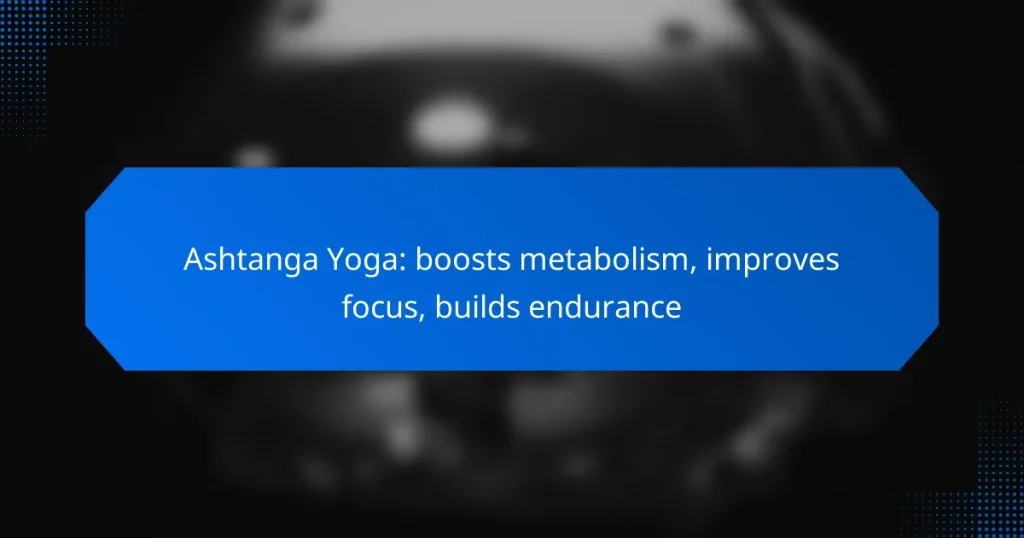Ashtanga Yoga is a dynamic practice that not only boosts metabolism by enhancing calorie expenditure and hormonal balance but also sharpens focus through the integration of breath control and mindfulness. Additionally, its structured series of postures builds endurance, promoting both physical strength and cardiovascular fitness. Embracing this holistic approach can lead to improved energy levels, mental clarity, and overall well-being.

How does Ashtanga Yoga boost metabolism?
Ashtanga Yoga boosts metabolism by increasing calorie expenditure, engaging muscles effectively, and promoting hormonal balance. These factors collectively enhance the body’s ability to burn calories and maintain energy levels throughout the day.
Increased calorie burn
Ashtanga Yoga involves a series of dynamic postures performed in a flowing sequence, which elevates heart rate and promotes calorie burn. Practicing this style of yoga can lead to burning anywhere from 300 to 600 calories per session, depending on the intensity and duration.
To maximize calorie burn, aim for sessions lasting at least 60 minutes, incorporating both strength and flexibility elements. Consistency is key; practicing several times a week can lead to more significant metabolic benefits.
Enhanced muscle engagement
This yoga practice requires the engagement of multiple muscle groups, which helps build strength and endurance. The combination of holding poses and transitioning between them activates both large and small muscles, contributing to overall muscle tone.
To enhance muscle engagement, focus on your alignment and breath during each pose. Incorporating variations or advanced postures can further challenge your muscles and stimulate metabolic activity.
Improved hormonal balance
Ashtanga Yoga can positively influence hormonal levels, particularly those related to stress and metabolism. Regular practice may help lower cortisol levels, which can lead to improved energy utilization and fat loss.
To support hormonal balance, consider integrating mindfulness and breath control into your practice. These elements can enhance the stress-relieving benefits of yoga, further supporting metabolic health.

How does Ashtanga Yoga improve focus?
Ashtanga Yoga enhances focus by integrating physical postures with breath control and mindfulness, creating a holistic practice that sharpens mental clarity. This combination fosters a deeper connection between mind and body, allowing practitioners to cultivate concentration over time.
Meditative breathing techniques
Meditative breathing techniques in Ashtanga Yoga, such as Ujjayi breath, play a crucial role in improving focus. By regulating the breath, practitioners can calm the mind and reduce distractions, which helps maintain concentration during practice. This focused breathing can also be applied outside of yoga sessions to enhance mental clarity in daily activities.
To practice Ujjayi breath, inhale deeply through the nose while slightly constricting the throat, creating a soft sound. Aim for a steady rhythm, allowing the breath to guide your movements and thoughts.
Mindfulness practices
Mindfulness practices in Ashtanga Yoga encourage practitioners to stay present and aware of their thoughts and feelings. By focusing on the here and now, individuals can minimize mental clutter and enhance their ability to concentrate on tasks. Regular mindfulness practice can lead to improved attention spans and reduced stress levels.
Incorporating mindfulness into your routine can be as simple as dedicating a few minutes each day to observe your thoughts without judgment. This practice can be integrated into yoga sessions or performed independently to strengthen your overall focus.
Structured sequences
The structured sequences of Ashtanga Yoga, known as vinyasas, provide a clear framework that helps practitioners focus on their movements and breath. Each sequence builds upon the previous one, promoting a sense of progression and mastery that keeps the mind engaged. This structure allows for a deeper exploration of each posture, enhancing concentration.
To maximize the benefits of structured sequences, practice consistently and aim to memorize the sequences. This familiarity will enable you to focus more on your breath and alignment rather than remembering the next pose, further improving your overall focus during practice.

How does Ashtanga Yoga build endurance?
Ashtanga Yoga builds endurance through a structured series of postures that progressively increase in intensity, demanding both physical and mental stamina. This practice enhances muscular strength and cardiovascular fitness, making it an effective way to improve overall endurance levels.
Progressive intensity levels
Ashtanga Yoga consists of a series of poses that are performed in a specific order, with each series increasing in difficulty. Beginners start with the Primary Series, which focuses on foundational postures, while more advanced practitioners progress to the Intermediate and Advanced Series. This gradual increase in intensity helps the body adapt and build endurance over time.
To maximize endurance gains, practitioners should aim to practice regularly, ideally three to six times a week. This consistency allows the body to adjust to the physical demands of the practice, leading to improved stamina and strength.
Consistent practice benefits
Regular practice of Ashtanga Yoga not only builds endurance but also enhances overall fitness levels. As practitioners become more familiar with the sequences, they can perform the postures with greater efficiency and control, reducing fatigue. This consistent engagement leads to long-term improvements in endurance and physical performance.
Additionally, the meditative aspects of Ashtanga Yoga help improve mental endurance, enabling practitioners to maintain focus and determination throughout their practice. This mental resilience translates into better performance in other physical activities.
Cardiovascular conditioning
Ashtanga Yoga is a dynamic practice that elevates heart rate, contributing to cardiovascular conditioning. The continuous flow of postures creates a workout that can be comparable to aerobic exercises, promoting heart health and endurance. Practitioners often find that their cardiovascular fitness improves alongside their strength and flexibility.
To enhance cardiovascular benefits, practitioners can incorporate breath control (ujjayi breathing) during their practice. This technique not only helps regulate heart rate but also increases oxygen intake, further boosting endurance levels. Regularly practicing at a vigorous pace can lead to noticeable improvements in stamina and overall fitness.

What are the prerequisites for starting Ashtanga Yoga?
To start Ashtanga Yoga, you should have basic yoga knowledge, a suitable level of physical fitness, and access to qualified instructors. These prerequisites help ensure a safe and effective practice, allowing you to fully benefit from the discipline.
Basic yoga knowledge
Having a foundational understanding of yoga principles is essential before diving into Ashtanga Yoga. Familiarity with basic poses, breathing techniques, and the philosophy behind yoga can enhance your practice and help you grasp the flow of Ashtanga sequences.
Consider attending beginner classes or workshops to build this knowledge. Resources like books or online tutorials can also provide valuable insights into the Ashtanga method and its unique structure.
Physical fitness level
Ashtanga Yoga is physically demanding, so a reasonable level of fitness is important. You should be comfortable with a variety of physical activities, as the practice involves strength, flexibility, and stamina.
Before starting, assess your current fitness level. If you engage in regular exercise, such as running or strength training, you may find the transition smoother. However, if you’re new to physical activity, consider starting with gentler yoga styles to build your strength and flexibility first.
Access to qualified instructors
Having access to qualified instructors is crucial for safely learning Ashtanga Yoga. Experienced teachers can provide personalized guidance, correct your alignment, and help you progress through the series effectively.
Look for certified instructors who have completed recognized training programs. Many studios offer introductory classes or workshops, which can be a great way to find a suitable teacher and establish a solid foundation for your practice.

What are the best Ashtanga Yoga studios in London?
London offers several top-notch Ashtanga Yoga studios that cater to various skill levels and preferences. Notable studios include Triyoga and The Yoga Tree, each providing a unique atmosphere and experienced instructors.
Ashtanga Yoga London
Ashtanga Yoga in London has gained popularity for its dynamic and structured approach to practice. This style emphasizes a series of postures linked with breath, promoting physical strength and mental clarity. Many studios offer classes ranging from beginner to advanced levels, making it accessible for everyone.
When choosing a studio, consider factors such as class schedules, instructor qualifications, and the overall environment. Some studios may also provide workshops and retreats, enhancing your practice further.
Triyoga
Triyoga is one of London’s premier yoga studios, known for its comprehensive Ashtanga classes. With multiple locations across the city, Triyoga offers a variety of sessions led by experienced teachers who focus on alignment and breath control.
The studio features a welcoming atmosphere and often hosts special events, including guest instructors and workshops. Membership options and drop-in classes are available, making it convenient for both locals and visitors.
The Yoga Tree
The Yoga Tree is another excellent choice for Ashtanga practitioners in London, offering a cozy and supportive environment. This studio emphasizes community and personal growth, with classes tailored to different levels of experience.
In addition to regular classes, The Yoga Tree frequently organizes events and teacher training programs. Their flexible pricing options, including class passes and memberships, cater to various budgets, ensuring that everyone can participate in the practice.

What equipment is needed for Ashtanga Yoga?
To practice Ashtanga Yoga effectively, minimal equipment is required. A yoga mat is essential for providing grip and cushioning, while optional props like blocks and straps can enhance your practice.
BODY REQUIREMENTS
Ashtanga Yoga emphasizes a strong physical foundation, so understanding your body’s requirements is crucial. Practitioners should be aware of their flexibility and strength levels, as these will influence their ability to perform various poses.
It’s beneficial to have a basic understanding of your body’s alignment and limitations. Regular practice can help improve these aspects, but starting with a solid foundation will prevent injury and enhance your experience.
DEPTH & COVERAGE
Ashtanga Yoga consists of a series of poses performed in a specific order, requiring focus and endurance. Practitioners should aim to master each pose before moving on to the next, ensuring proper technique and alignment.
Consider starting with the primary series, which includes foundational poses that build strength and flexibility. This series can take several months to master, so patience and consistency are key.
ACTIONABLE GUIDANCE
When beginning Ashtanga Yoga, invest in a high-quality yoga mat that provides adequate grip and cushioning. Avoid overly thick mats, as they can hinder balance and stability.
Consider using props like blocks and straps to assist with alignment and to deepen stretches. These tools can help prevent injury and make challenging poses more accessible.
Be mindful of your body’s signals. If you experience pain or discomfort, modify the pose or take a break. Listening to your body is essential for a sustainable practice.


